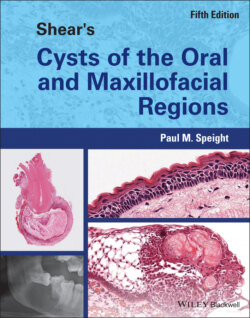Читать книгу Shear's Cysts of the Oral and Maxillofacial Regions - Paul M. Speight - Страница 27
Pathogenesis of Cysts
ОглавлениеThe formation of a cyst requires three elements and can be considered to develop in three phases: a phase of initiation, a phase of cyst formation and a phase of growth and enlargement (Box 2.1). For the inflammatory odontogenic cysts, the processes of cyst formation and expansion are well understood and are considered in detail in Chapters 3 and 4, but for the developmental cysts the mechanisms are not so clear and many theories have been suggested, including aberrant developmental processes, underlying genetic abnormalities, and neoplasia. These are discussed in detail for each cyst type in the following chapters. For most cysts, the lining is derived from epithelial remnants or inclusions that remain in the tissues after developmental processes are complete. Table 2.1 shows the source of epithelium for each cyst type and summarises the developmental origin. To fully understand the pathogenesis of cysts, it is therefore essential to have an understanding of the embryology and development of the head and neck. With regard to the odontogenic cysts (and odontogenic tumours), a thorough knowledge of tooth development is also needed to understand the pathogenesis, since the complex interactions between epithelium and mesenchyme that underpin normal morphogenesis and tooth eruption provide good models for the processes that drive cyst formation and growth. In addition, the histology of many lesions may recapitulate the features of the developing tooth and knowledge of these features facilitates the ability to reach an accurate diagnosis. A detailed consideration of embryology and development is beyond the scope of this book, but factors relevant to each cyst type are summarised in each chapter. For up‐to‐date and expert knowledge relating to development, readers should consult expert texts or reviews (Wise et al. 2002 ; Nel et al. 2015 ; Nanci 2017 ; Seppala et al. 2017 ; Diniz et al. 2017 ; Hovorakova et al. 2018 ; Bastos et al. 2021 ).
